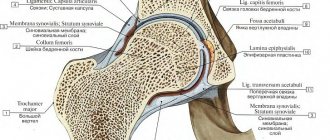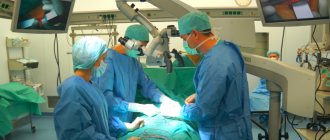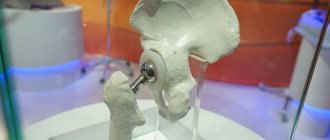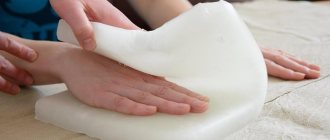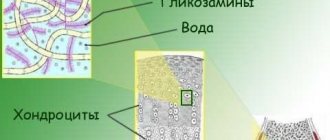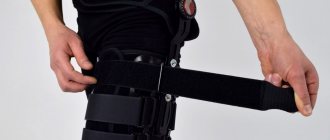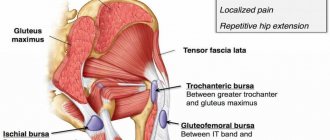A rigid orthosis is made from composite materials or plastic and is used to provide rigid fixation to the joint. Its use is recommended after operations. At the same time, there are models that completely eliminate movement (splint) or are equipped with a hinge mechanism that allows you to adjust the angle of hip abduction.
Soft bandages are made of cotton or nylon. They are designed to be worn during recovery or rehabilitation after injury. Bandages do not have hinges, but at the same time they provide the necessary support to the joint and have a compression effect, relieving excessive load from it.
Both types of orthoses can be unilateral or bilateral (depending on the injury). The principle of fixation and their design are also similar: one part is attached to the waist, the second fixes the thigh, ensuring load and movement limitation according to the type of device.
Product selection
When choosing an orthosis for a femoral neck fracture, the doctor’s recommendations play an important role, taking into account the characteristics of the injury, the surgical and therapeutic treatment performed, and the presence of concomitant diseases. An important point when choosing is also to take into account the individual characteristics of the patient (age, height, weight, waist circumference).
Among soft bandages, models with Velcro are popular, the sizes of which can be independently adjusted.
This type of fixation devices also has its contraindications, the main of which are inflammatory processes of the skin in the area of injury and individual allergic reactions to the material. To avoid inflammation, it is recommended:
- wear bandages over thin underwear;
- follow the regimen prescribed by the doctor.
How to choose and buy a hip orthosis for coxarthrosis
The first step if you suspect arthrosis is to consult a doctor. If you do not pay attention to pain and discomfort in time, the disease may develop into a chronic form or complications that cannot be treated will arise. Based on the clinical picture, the doctor will be able to determine the method of treatment, including the use of an orthosis.
The Allorto online store offers a wide range of health products of European quality. We cooperate with leading manufacturers and suppliers in Russia. To place an order for a hip orthosis for coxarthrosis, add the item to your cart and follow the prompts. If you need advice, call us by phone: the operator will help you choose a model and size, and tell you about payment methods. You can receive the goods anywhere in the Russian Federation, either at the transport company’s terminal or at a convenient address for you.
Effect of use
Bandages, orthoses, splints play an important role in the treatment of complex pathology - femoral neck fracture. With their help, it is possible to solve a number of therapeutic problems:
- removing the load from the injured joint,
- the ability to regulate traffic intensity,
- providing compression support for muscles,
- prevention of re-injuries,
- significant reduction in pain.
In this case, the choice of a rigid model with or without hinges will be the optimal solution after the operation or in the initial stage, when the primary goal is reliable fixation of the joints for proper fusion.
Soft bandages will become an indispensable support during the recovery and rehabilitation periods, helping to reduce pain, distribute the load, and quickly return the necessary mobility to injured joints. The main guarantee of the effective use of a bandage for a femoral neck fracture remains the correct choice of product, based solely on the recommendations of a specialist with mandatory consideration of the patient’s individual parameters.
Hip orthoses for coxarthrosis
Coxarthrosis or arthrosis of the hip joint is a disease characterized by the destruction of cartilage structures.
The disease can develop against the background of age-related changes, physical activity, or congenital or acquired pathologies. Coxarthrosis is progressive, develops over several years and becomes chronic. At the same time, the victim experiences pain when walking and discomfort due to limited joint mobility. Coxarthrosis can be either bilateral or can affect only one side. For the treatment and prevention of coxarthrosis of the hip joint, it is recommended to use orthoses - a type of joint fixation. During use, the orthosis fixes the damaged joint, limiting its mobility and relieving it from excess loads. In this way, faster and more effective restoration of articular structures occurs. Treatment and prevention of coxarthrosis require careful attention to your health and strict adherence to all doctor’s prescriptions and recommendations.
Difference between cemented and cementless endoprosthetics
The main differences lie in the method of securing the implant to the bone. The implants themselves differ in material, coating and appearance. In addition to cemented and cementless, there are also reverse hybrid endoprostheses.
Types of implants according to the method of fixation:
- Cement prostheses are fixed with polymer cement made from polymethyl methacrylate. This allows you to “adjust” them to any, even very wide, canal of the femur.
- Cementless endoprostheses are installed using the press-fit method , that is, by “tight fit”. The implant components are hammered into the bone canals. Before installing the prosthesis, the shape of the bone canals is corrected with rasps.
- The femoral components of hybrid endoprostheses are fixed using the “tight fit” method, the remaining components (acetabulum or tibial, patella) are fixed with cement.
Table 1. Main differences between cemented and cementless prostheses.
| Characteristics | Cement | Cementless | Hybrid |
| Fixation method | Landing on a fixing substance – polymer cement. | Impacting into the bone canal using the press fit method after processing it with a rasp. | Cementless installation of the femoral components and cement fixation of the rest. |
| Material | Cement-retained legs are made from cobalt-chrome or cobalt-chromium-molybdenum alloy. Cups are made from medical polyethylene. | Endoprostheses made of titanium-based alloys (titanium-aluminum-vanadium or titanium-aluminum-niobium). It is noteworthy that in such implants you can choose a friction pair. | Individual fragments of prostheses can be made from a variety of materials. |
| Coating | They are not sprayed. The surface of such implants is usually sanitized or polished. | A porous or hydroxyapatite coating that facilitates ingrowth. | The method of surface treatment depends on how it is planned to install the components of the prosthesis. |
| Appearance | They have a smooth, polished surface. | Usually look rough. | May have different appearance. |
Minimally invasive endoprosthetics in the Czech Republic: doctors, rehabilitation, terms and prices.
Find out more
What is the danger of coxarthrosis
The hip joint is subjected to enormous stress every day, so without treatment the disease progresses. If you don't take action, sooner or later:
- pain in the leg will become constant and will bother you even at night;
- posture will worsen, spinal osteochondrosis will develop;
- the diseased leg will become shorter than the healthy one;
- for walking you will need additional devices, such as a cane.
Coxarthrosis in an advanced state can lead to disability
1.1. New understanding of the etiology of ANFH
A new understanding of the etiology of aseptic necrosis of the femoral head is a breakthrough in the established ideas of academic medicine. When conducting research, it was established that the causes of ANFH are associated with the concentration of stress in its head, destruction of its structure, fragmentation of the mesh structure of trabeculae, their twisting, overlap, degeneration and change in the shape of the femoral head. The concentrated stress causes destruction of both the bone structure and the internal structure of the femoral head. A change in bone structure inevitably leads to compression and destruction of the capillary network, interferes with blood circulation, provokes the occurrence of ischemia and pathological processes, perversion of metabolic processes and malnutrition of the bone.
Thus, the pathogenesis of ANFH is associated with ischemia and other factors leading to concentration of stress in the femoral head, destruction of trabeculae, creation of obstacles to blood circulation and perversion of metabolic processes.
1.6. Toolkit of the new method
The patented technology used by the authors - a new method of treating ANFH - combines modern high technologies and principles of Chinese medicine.
● Image diagnostics
– a computer graphic display system of ANFH, developed within the framework of a new method, uses quantitative changes in the microstructure and conducts a morphological analysis of the structure of the femoral head.
● Treatment with electrical impulses –
A device for the treatment of ANFH supplies electrical signals to biologically active points, thereby regulating the electrochemical environment in the bone and optimizing the growth of new bone tissue.
● Phytotherapy
– preparations from the “Chengzai” series not only increase the body’s resistance, restoring its normal functions, but also improve the mechanical properties of trabeculae, restore the structure of the trabeculae and microcirculation. They also remove fat droplets from cartilage and bone tissue.
● Theory about the displacement of muscles and bones
- “a method of regulating the balance of the pelvis”, used in Chinese traditional medicine, eliminates pelvic distortion, straightens the spine, restores the parallelism of the lines of the sciatic angle and the size of the obturator foramina.
● Rehabilitation theory
– electromechanical effect of “a method of modeling the hip joint, elasticity of the joint, and strengthening bones and muscles” used in Chinese medicine.
● Exercise therapy according to an individual plan
– involves creating restoration tension throughout the course of treatment to accelerate the growth and development of new bone.
It should be noted that during treatment, the patient has the opportunity to gradually adapt and socialize while maintaining a familiar communicative environment. Improved well-being, disappearance of pain, increased range of motor functions create confidence in the patient’s abilities. These circumstances create a positive attitude and confidence in both the patient and his relatives in the successful outcome of the disease.
How is coxarthrosis treated at the third stage?
At a late stage, conservative treatment of osteoarthritis is ineffective. Doctors recommend replacing the destroyed joint with an endoprosthesis. Unipolar - replaces only the femoral head, bipolar - the head and acetabulum. The operation is performed after a full examination and under general anesthesia, followed by antibiotic therapy and a complex course of rehabilitation measures. Repeated intervention, provided all requirements are met, the patient may need in 15-20 years.
Traditional medicine approaches the treatment of coxarthrosis as follows:
1.7. Early diagnosis
Necrosis of the femoral head does not occur instantly; the disease is protracted, and the patient does not attach importance to the initial manifestations of the disease for a long time. The most common clinical symptoms are discomfort or pain in the hip joint during overload or after a long walk, but its intensity decreases after rest.
During the development of ANFH, pain often occurs in the lumbosacral region or knee joints, which can be mistakenly taken for prolapse of the lumbar intervertebral disc and narrowing of the spinal canal, sciatic neuralgia, rheumatoid arthritis, synovitis, etc. A feature of this disease is that the strength the experience of subjective symptoms does not depend on the degree of development of ANFH.
In no case should the patient be careless and remember that as the pain and lameness intensify, the functions of the hip joint are gradually limited. If time is lost to restore the mechanics of the femoral head, then the disease becomes irreversible, i.e., bone collapse or fibrous fusion of the articular surfaces occurs, which in the late stage leads to rigidity of the hip joint and disability.
In this regard, great attention should be paid to the problem of early diagnosis of the disease. Using data from regular clinical examinations and examinations by therapists and traumatologists, the authors formulated an algorithm for identifying the patient’s ANFH disease at an earlier stage.
Among the clinical manifestations, the following are alarming and require a comprehensive and dynamic assessment: pain in the hip joint, pain in the groin area with radiation to the knee joint, limitation of movements in the hip joint, signs of muscle atrophy, unmotivated pain in the knee joint. Particular attention is paid to patients at risk.
The presence of these clinical signs is the basis for special research methods:
- plain radiography of both hip joints using Launstein placement;
- magnetic resonance imaging, which makes it possible to diagnose ANFH in 90-100% of cases already at the initial stage of the disease;
- static and dynamic scintigraphy of the femoral head and skeleton for diagnosis and exclusion of specific processes;
- laboratory assessment of the endocrine status of indicators of mineral, carbohydrate and fat metabolism;
- X-ray dual-energy densitometry of the femoral head;
- processing of X-ray images in a computer program to determine the structure of the femoral head, assess the condition of trabeculae, identify necrotic zones, etc.
Advantages and disadvantages of fixation methods
Undoubtedly, both types of endoprosthetics have both advantages and disadvantages. However, in general, the outcome of the operation depends not only on the cost and characteristics of the implant. As we have already said: everything is in the hands of the surgeon!
Table 2. Pros and cons of different types of endoprosthetics.
| + | — | |
| Cement |
|
|
| Cementless |
|
|
Carrying out the operation
The operation is performed under general anesthesia and lasts about 2.5 hours. If the patient has contraindications such as intolerance to conventional anesthesia, he may be offered an alternative in the form of epidural anesthesia. Then he will remain conscious throughout the operation.
Depending on which joint we are talking about, arthrodesis has its own protocol, which it is important to adhere to as precisely as possible. Upon completion of the operation, the patient is transferred to the hospital under the temporary supervision of medical staff.
Regardless of whether hand arthrodesis or foot arthrodesis surgery was performed, it is necessary to be aware of the signs of complications. So, if you notice a change in the color of the skin around the cast (redness, greying) or blood stains appearing through the bandage, or if you feel a tugging, growing pain, you should immediately consult a doctor.
How to wear a bandage correctly
Each product comes with an instruction manual that tells you exactly how to use the thigh brace.
- The product should be worn on thin cotton underwear and only in a lying position. This way the muscles relax well.
- Before going to bed, remove the product. The exception is rigid orthoses, which, as prescribed by the doctor, must be worn constantly for a certain period of time.
- If the product is faulty, then it is not worth wearing, much less repairing it yourself.
- When putting on the fastener, you should not pull the fasteners too much, so as not to break them. If the fixing parts are broken, the orthosis fails and its use is pointless.
Orthopedists advise buying orthoses that are adjustable with straps or Velcro. This way, when gaining excess weight, the patient will not need to buy a new device.
Rules for wearing a bandage
